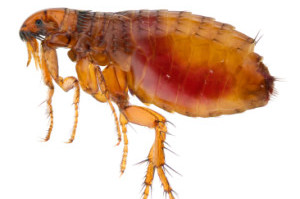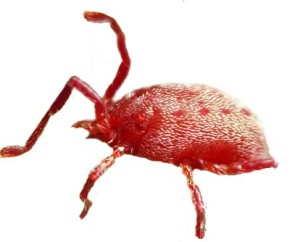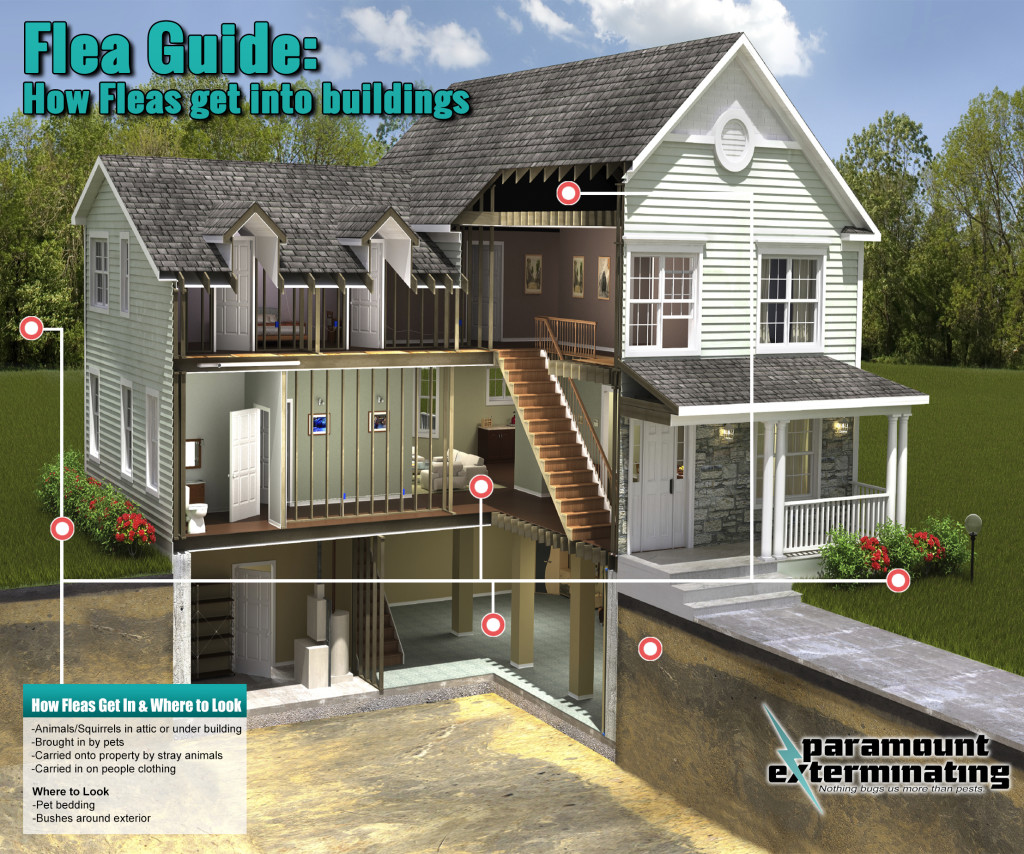FLEAS/BITING INSECTS
Fleas and other skin irritating pests like ticks, springtails, and mites aren’t just problems for people with pets. Find out what is biting you, it may not be what you think!
STOP ITCHING, STOP WONDERING WHAT IT IS!
- Identification – Treating a problem correctly means first knowing the type of pest you are dealing with. Your technician will do a thorough inspection to assess if pest activity is present and properly identify the insect so that we can provide the right treatment plan.
- Flea Treatments – Areas that are experiencing problems with fleas should be treated by a professional exterminator in conjunction with a flea treatment and flea collar for any pets. If you do not have pets, its possible that an animal is living nearby that is causing the problem. We will ask for details about the property and problem areas prior to scheduling your inspection/treatment.
- Tick Treatments – Outdoor pests like ticks can create unusable yards and spread disease. We attack the problem at the source by treating the properties exterior, and by treating effected areas on the inside. Areas where pets sleep or congregate are often areas of concern, as they frequency carry ticks indoors.
- Mite Treatments – Depending on the type of mite that is found, we will create a treatment plan to eradicate the problem. Since mites can come from a variety of sources, removing the problem completely often means locating the source of the problem and removing it. Common mite problems include bird mites, dust mites, mites from mice and rats, and other animals.
HOW DOES PARAMOUNT GET RID OF FLEAS/TICKS/MITES?
- Flea Treatment - Inspection & Treatment
- Tick Treatment - Inspection & Treatment
- Mites/Other Skin Irritating Pests - Inspection & Treatment
FLEA TREATMENT: INSPECTION AND TREATMENT
Your technician will assess the problem and perform the initial treatment. Spraying, dusting, or fogging methods are all applied based on what the technician finds during your inspection. This service generally takes 45 minutes to a few hours depending on the size of the space and will knock out the majority of your flea activity. We come back to reinspect and retreat the property 1-2 weeks after the initial service to make sure the entire problem is removed.
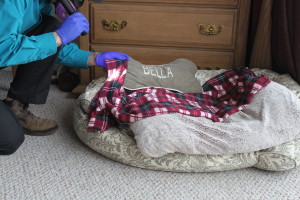
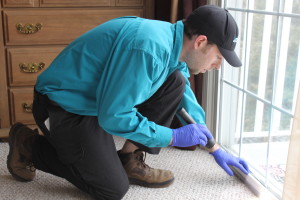
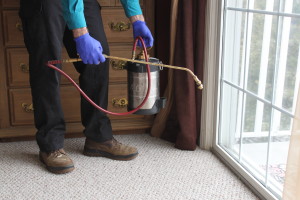
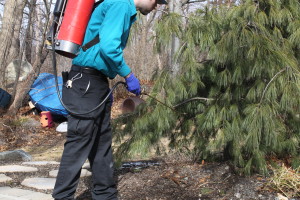
TICK TREATMENT: TREATMENT AND INSPECTION
First, your technician will inspect your properties exterior and any interior areas that you are finding ticks. Once the treatment areas have been determined, your technician will treat accordingly. This often includes treating the exterior perimeter of the building, surrounding bushes and trees, and interior areas where pets sleep or congregate. This treatment can take 45 minutes to a few hours depending on the size of the property and the affected areas.
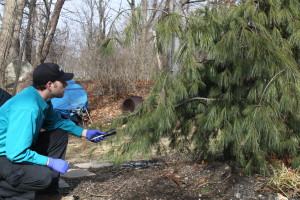
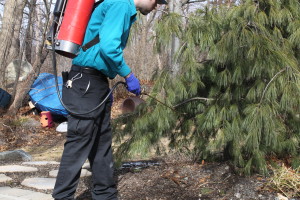
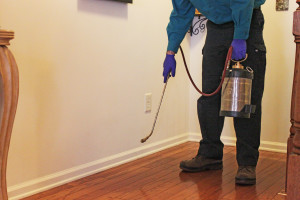
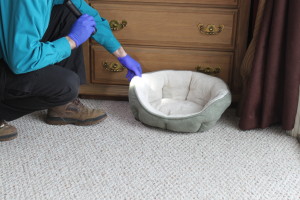
MITE TREATMENT: INSPECTION & TREATMENT
While most problems can be handled the day of the initial inspection, mite problems can take a bit more effort. Due to mites coming from a variety of sources (rodents, animals, bats, birds, etc.), first we must determine the type of mite or where they are originating from. In certain cases, removing mites completely may mean eliminating another problem like rodents. We need to stop mites at their source to stop them from returning. This process can take longer than other pest treatments due to these complications. The most important thing to remember with mites is to choose an exterminating company that you trust and has experience dealing with this type of pest.
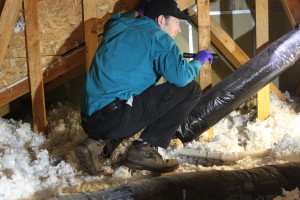
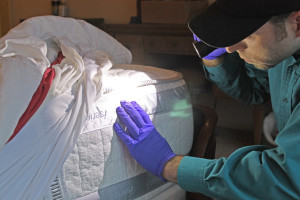
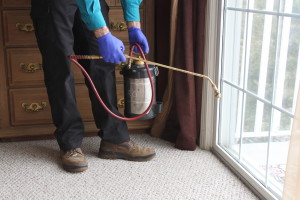
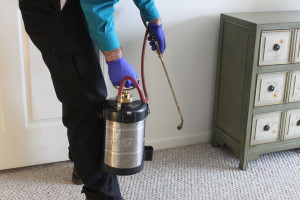
FREE ESTIMATES – ZERO OBLIGATIONS
FLEA/TICK/MITE FACTS
Pest Entry: Biting and skin irritating insects come from a variety of places, some come from the outdoors and others are generally found in-doors. They can be, and often are, brought in on people and household pets.
Environment: Most biting insects need a host to survive. This means they can survive a variety of environments but are often found in moderate climates.
Reproduction: Skin irritating pests can become a problem very quickly as they may go unnoticed for some time. Small bites and skin irritations are usually quickly written off as mosquito bites or the occasional spider bite. In some cases, people do not have any reaction to these bites and may not even know that they have a problem.
Health Concerns: These pests can cause a variety of symptoms from itchy bites and allergic reactions, to serious illness in the case of certain ticks. Reoccurring bite marks or skin irritations should be treated by a medical professional and a thorough inspection should be done on the home to inspect for these pests.
Home Remedies: The best method to help eliminate these pests is to call a professional. Inspecting your surroundings can be crucial to catching a developing problem in its early stages. Occasionally screening your pets for fleas or ticks can go a long way as well, especially if they are indoor/outdoor pets.
WHAT TYPE OF PEST IS IT?
Appearance: Averaging an 1/8th inch in length, fleas are small parasitic pests that are a shiny, reddish-brown color. Their bodies are covered in microscopic hairs, and they have piercing mouth parts that allow them to feed on a host animal.
Habit: Fleas will attach themselves to a variety of hosts including cats, dogs, humans, chickens, mice, rabbits, and other animals. They are often seen in homes with pets, especially in-door/out-door pets like cats. After the fleas have attached themselves to a host animal, the animal may come inside bringing the fleas with it. The fleas will feed on the host animal, often causing itchy or irritated skin, and then lay eggs on the host’s fur.
Health/Damage Concerns: Humans and pets that are subjected to flea bites will have itchy, irritated skin and will scratch frequently. Some people are allergic to fleas, and bites can mean more than just irritated skin. Fleas are also known to carry diseases like Tularemia and Typhus which are dangerous to humans.
Diet: Parasitic blood-feeder; adult fleas will feed on the host animal, while their larvae will feed mostly on adult flea feces as it contains small quantities of blood. Larvae feed on organic debris, particularly the feces of adult fleas, which contain undigested blood.
Reproduction: Fleas will often lay their eggs directly on the host animal, but these eggs will eventually fall off. These dropped eggs often lead to infestations in various areas around a home. Eggs hatch within 14 days, and the larvae hide in cracks and crevices around the home. Larvae will often feed for an average of two weeks before beginning the pupation process. The pupation process will also last around two weeks, with adult fleas emerging from the cocoon looking for a new host.
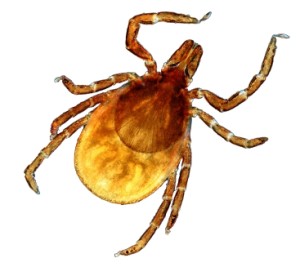 Name: Ixodidae (Hard ticks), Argasidae (Soft ticks)
Name: Ixodidae (Hard ticks), Argasidae (Soft ticks)
Appearance: Adult ticks measure between 1/8th inch and ½ inch depending on if it is engorged from feeding. Immature ticks are smaller, usually around 1/16th of an inch. Their coloring varies from species to species. Adults have eight legs, immature nymphs have only six.
Habit: Ticks are often found in wooded areas, especially areas will tall grasses and lush vegetation. They are seen more frequently in warm, humid climates or in the summer months in areas like NJ. This is because most ticks have difficulty adapting to colder temperatures and need a certain level of humidity to survive. Dense tick populations can be found in wooded areas near rivers and streams, and where large populations of wildlife exist.
Health/Damage Concerns: Ticks carry a variety of harmful diseases including Lyme disease, Rocky Mountain spotted fever, tularemia, tick-borne meningoencephalitis, relapsing fever, babesiosis and cytauxzoonosis.
Diet: Blood-feeders; most species feed on mammals, birds, and even reptiles.
Reproduction: The life-cycle of most ticks takes place in four stages; the egg stage, larval stage, nymph (immature) and adult stage. A female tick will attach itself to a suitable host and take a blood meal. She will then release herself from the host and find a crevice near the floor to lay her eggs in. This is often a crack in a wood floor or in the gaps around molding. Adult female ticks can lay 3,000 eggs at a time in cracks and crevices around the home resulting in large infestations that appear to happen overnight. Once the eggs hatch, the larvae stay dormant until a suitable host is found. The larvae will take a blood meal and return to a hiding area to begin the transformation from larvae to nymph. Newly emerged nymphs will then seek out a host by climbing nearby objects and walls. The nymphs will then go into hiding again to molt for the last time. Once adult ticks emerge, they will again search for a host. After attaining a blood meal, the adult tick will climb up to a high area to process the food and then return to the ground afterwards. Most people do not realize they are having a problem with ticks until they are found on the family pet or seen climbing up walls after a blood meal to look for a high place to process their food.
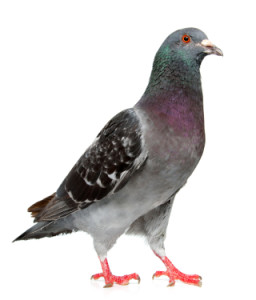 Name: Macronyssidae (family), Dermanyssidae (family.
Name: Macronyssidae (family), Dermanyssidae (family.
Appearance: Bird mites are less than 1mm in length and are almost transparent in color. They turn a brownish-red color after collecting a blood meal. Their bodies are typically an oval shape and covered in short hairs.
Habit: Bird mites are often found in homes where birds frequently visit or nest. They can be brought in-doors on peoples clothing, pets, or just by wandering in on their own. They are capable of moving quickly for their size and are known to infest homes rapidly due to their frequent breeding. Bird mites will often stay with one particular host for as long as possible, only migrating after the host has died or a nest site has become unusable and the birds populating the area have travelled in search of a new nesting site. When this happens, thousands of mites may travel in search of a new host, often moving in-doors to find a blood meal. Bird mites cannot survive for longer than 10 days without finding a food source. They are most active at night, and on humid or overcast days.
Health/Damage Concerns: Due to their very small size and nearly transparent color, a bird mite infestation may go unnoticed until a large infestation has occurred. Populations are known to grow quickly, and bites from bird mites can cause irritated welts that last much longer than the mosquito bites for which they are commonly mistaken.
Diet: Blood from birds and other animals.
Reproduction: Bird mites reproduce at an alarmingly quick rate. Females generally make up to 90% of a bird mite population, and infestations can reach into the thousands if mites have a suitable host and the proper environment to survive in. Bird mites cannot complete their lifecycle on a human host, and will often perish if no other avian host is found. Once a host bird’s nest area is eradicated, problems with mites soon disappear.
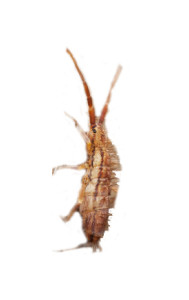 Name: Collembola (Common Names: Springtail, Snowflea)
Name: Collembola (Common Names: Springtail, Snowflea)
Appearance: Averaging 6mm in length, with a segmented body. Springtails are normally white, grey, or brownish in color, with tiny hairs extending off of its body. Collembola do not possess a typical breathing system like most pests. Instead they use small pours on their bodies to take in air. They also have a tail-like appendage that allows them to jump into the air when disturbed, hence their common name – springtail. These pests are often confused for fleas.
Habit: Springtails are commonly seen inhabiting loose soil in woodlands and forests, areas of vegetation and decaying plant matter, and on the surface of ponds or other calm bodies of water. In the wild, springtails are hardly noticed and don’t become a pest until they are accidently brought into a home. Like most pests, they need a food and water source for survival, and are sometimes found around the home in kitchens, bathrooms, basements, and areas where it’s damp. The unique feature of springtails is that they can withstand the changes in temperature that occur from summer to winter. The common name, snow flea, comes from the fact that they are often seen outdoors during the winter despite the cold temperature.
Health/Damage Concerns: There is some controversy surrounding the interaction of springtails and humans. There are people that believe that springtails may be a human parasite, and there are documented cases of people claiming to be “infested” by springtails. They say that they can feel them underneath their skin causing severe irritation, scratching, and paranoia. Most researchers believe these cases to be untrue and say the springtail biology would not allow them to be a parasitic creature, especially to humans. Although, the hair that springtails have on their bodies has been documented to cause skin irritations.
Diet: Decaying organic matter; mold, decaying plant matter, fungus and bacteria.
Reproduction: The process of springtail reproduction is unique and can vary from species to species. Males will often scatter sperm sacks, called spermatophores, around an area in which there are females. The females use these spermatophores to create their offspring. Some females even have the ability to lay eggs with no male interaction. Eggs hatch in as little as 3 to 5 weeks, and the springtail emerges as a nymph that looks similar to an adult. These pests also go through several molts stages in the process of becoming an adult.
Appearance: Almost microscopic in size, chigger mites average 0.4mm in length and are reddish-orange in color. They are a relative of ticks.
Habit: Chigger mites thrive in areas with dense grass and vegetation. They are commonly found in woods, orchards, near lakes and streams, and anywhere there is abundant plant life and moisture. They are often seen during the late spring/early summer months when grasses and vegetation are at their peak. They have also been spotted in low grasses on golf courses, in parks, and on sports fields.
Health/Damage Concerns: The larval and nymph stages of this pest feed on skin cells, causing severe irritation for animals and humans when affected. Consult a trusted and knowledgeable physician if you are experiencing skin irritations similar to that caused by mites or fleas.
Diet: Adults feed on plant materials; larvae are parasitic and feed on the skin cells of humans and animals alike. After finding a host, the larvae will create a hole in the skin and inject a digestive enzyme that breaks down the tissue and enables them to feed on the broken down skin cells. This often causes severe irritation, swelling, itching around the affected area, and red, pimple-like rashes to form. Most irritation does not begin until 24 hours after the larvae has completed feeding making it difficult to diagnose where the irritation came from.
Reproduction: Like ticks, chigger mites go through a four-stage lifecycle; egg, larvae, nymph, and adult. Females will lay four to eight eggs in a protected area at a time, laying up to 15 eggs a day. Larvae will emerge after 6 days, and travel up high grasses and plants in search of a host. Once a suitable host is found, the larvae will feed for several days before dropping off of the host and beginning the transformation into the nymph stage. Females will continue to lay eggs until the temperature begins to drop, with most perishing by the early fall. These pests can breed and survive all year if in a favorable environment like in warmer climates or inside the home.
FLEA/TICK/MITE LOCATION GUIDE
– Find out where to look for Fleas/Ticks/Mites –
Why Families and Businesses Choose Paramount
- Faster Service – Get your services scheduled quickly and on YOUR time. No one wants to wait weeks for treatment, and we get that.
- Local and Reliable – We have pest control technicians in Union City, Jersey City, Hoboken, Weehawken, North Bergen, and Hudson County everyday to assist our customers at a moments notice!
- More Efficient – We get things done right the first time, saving you time, money, and frustration.
- Better Tools – Our technicians only use the best products available on the professional market making treatments more effective and longer lasting.
- Better variety of treatment methods – including green treatments and baiting programs.
- More Experience – We’ve been defeating pests since 1930, and have the most experienced technicians in the industry.
Click HERE For A Free Estimate!
With a free estimate from one of our experienced professionals, you learn about all of the benefits of Paramount’s services. We will work with you to design a specialized program specific to your needs! Call or click for a free estimate.


